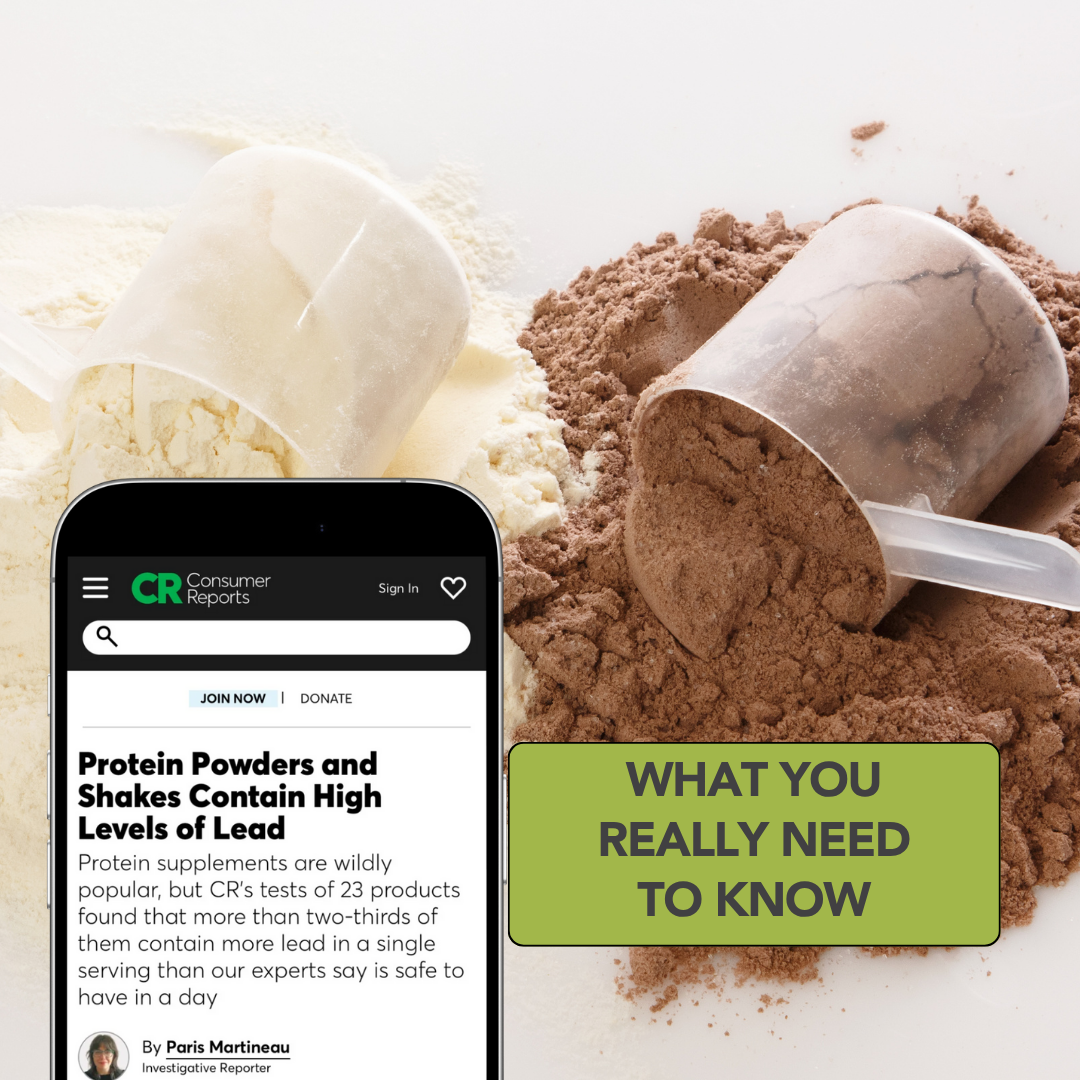Lead in Protein Powders: What You Need to Know
Recap of Article
Consumer Reports tested 23 protein supplements including powders and ready-to-drink shakes made from dairy, beef, and plant-based proteins.
They found two-thirds of the products contained more lead in a single serving than what Consumer Reports considers safe for an entire day.
All the plant-based powders tested had pea protein as their main ingredient.
The products were analyzed for a variety of factors including total protein content, arsenic, cadmium, and lead — but the most concerning findings were related to lead levels.
On average, plant-based protein powders contained about 9x more lead than whey or dairy-based proteins. This is likely because plants easily absorb whatever is in their environment, from beneficial nutrients to unwanted contaminants like heavy metals in the soil, water, and air.
Animal-based proteins, , such as those made from milk (e.g., whey), can also be affected by environmental exposure through the cow’s feed, water, and soil, though typically to a lesser degree.
what is lead?
Lead is a naturally occurring element in the earth’s crust, but it is also a toxic metal that can harm your body.
where is lead found?
Lead is everywhere in the environment — air, soil, water, and even inside homes. Historically, it has been used in products like paint, ceramics, pipes and plumbing materials, gasoline, batteries, ammunition, and cosmetics.
Common exposure:
Drinking water: Lead can leach from old pipes, faucets, and plumbing fixtures. Using a water filter can help reduce exposure.
Food: Lead can be present in foods from contaminated soil or during processing.
Crops: Fruits, vegetables, grains, and cocoa beans (chocolate) grown in lead-contaminated soil.
Imported products: Some candies and spices may contain lead due to unsafe processing or storage. Common examples include chili powder, curry powder, turmeric, coriander, anise seeds, and cloves.
why is lead harmful?
Affects brain, liver, kidneys, and bones
It is stored in teeth and bones
Lingers in the body, so even small amounts repeated over time can be dangerous
lead regulations
Currently, the Food and Drug Administration (FDA), which monitors lead in foods, has not identified a safe level of lead exposure. Supplements, including protein powders and shakes, are even less regulated — the FDA does not set limits for heavy metals in these products. This isn’t surprising, since dietary supplements do not require pre-market approval and companies don’t have to prove their products are safe before selling them.
To help assess risk, the FDA has established an interim reference level (IRL) — a benchmark for when lead exposure from food might pose a health concern. The IRL is based on the CDC’s blood reference level of 3.5 µg/dL for children. It also includes a 10× safety factor, meaning it’s set ten times lower than the amount of lead that could actually raise blood levels above that threshold.
The current FDA IRLs are:
Children: 2.2 µg/day
Women who could become pregnant: 8.8 µg/day
For now, these are the only groups with official guidance from the FDA.
California Prop 65
California Law Prop 65 requires businesses to inform residents about drinking water sources exposed to chemicals that can cause cancer, birth defects, or other reproductive harm. For lead, the law sets a maximum safe dose of 0.5 µg/day for reproductive risk and 15 µg/day for cancer.
Prop 65 also sets limits for lead compounds, such as lead acetate, lead phosphate, and lead subacetate, each with its own allowable levels. Since Consumer Reports only references 0.5 µg/day for lead, it’s safe to assume they were testing for elemental lead specifically, not these other forms.
How to limit exposure
Choose whole-food high in proteins: eggs, cow’s milk, Greek yogurt, poultry, lean meat, fish, beans, lentils, quinoa, tofu
Use supplements intentionally: Protein powders and shakes should supplement your diet and serve as an ergogenic aid to support performance, not as your main source of protein.
Look for third-party certification that test for heavy metals:
NSF Certified for Sport® — tests for heavy metals and banned substances
USP Verified® — tests for heavy metals, but not always banned substances (important for athletes)
Q&A: Does flavor of protein powder or shake matter?
No. Consumer Reports found no significant difference in lead levels between vanilla and chocolate protein powders and shakes.
Recommend focusing on product quality, third-party certification, and reading the ingredient and supplement facts instead.
References
Centers for Disease Control and Prevention. (2025, August 21). About childhood lead poisoning prevention. https://www.cdc.gov/lead-prevention/about/index.html
Consumer Reports. (2025, October 14). Protein powders and shakes contain high levels of lead. https://www.consumerreports.org/lead/protein-powders-and-shakes-contain-high-levels-of-lead-a4206364640/
Minnesota Department of Health. (2024, September 24). Common sources of lead. https://www.health.state.mn.us/communities/environment/lead/fs/common.html#foodandspices
Office of Environmental Health Hazard Assessment. (n.d.). Lead. California Environmental Protection Agency. Retrieved October 21, 2025, from https://oehha.ca.gov/proposition-65/chemicals/lead
Office of Environmental Health Hazard Assessment. (n.d.). Proposition 65. California Environmental Protection Agency. Retrieved October 21, 2025, from https://oehha.ca.gov/proposition-65
U.S. Food and Drug Administration. (2025, January 6). Lead in food and foodwares. https://www.fda.gov/food/environmental-contaminants-food/lead-food-and-foodwares
U.S. Environmental Protection Agency. (2025, September 9). Learn about lead. https://www.epa.gov/lead/learn-about-lead#lead
World Health Organization. (2024, September 27). Lead poisoning and health. https://www.who.int/news-room/fact-sheets/detail/lead-poisoning-and-health

